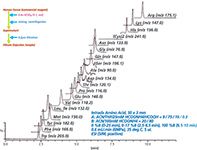Intrada Amino Acid Separates Intact Amino Acids in Human Serum
We have previously shown the ability of a novel stationary phase to separate 55 amino acids without derivatization (LCGC 32(3), 211 [2014]).
We have previously shown the ability of a novel stationary phase to separate 55 amino acids without derivatization (LCGC32(3), 211 [2014]). One of the recurring comments we received has been that our samples were standards which could potentially behave differently compared to samples derived from more complex matrices. Here, we show that the Intrada Amino Acid column separates amino acids without derivatization in complex samples equally effective as it does for standard samples, with very little change in retention time.
This new technology will undoubtedly prove to be a valuable addition to the industries currently analyzing amino acids, such as nutritional supplements, clinical testing laboratories and cell culture monitoring. In this experiment we sought to prove that our previous results with samples derived from standard amino acids are similar to those derived from complex sources, further implicating the value of this novel stationary phase to these industries.
Experimental
First, 0.5 mL of human serum (commercial grade reagent, Cosmo Bio Co. Ltd) was subject to protein crash with 0.5 mL of 0.4 N HClO4 and centrifuged (6000 rpms, 10 min). Supernatant was filtered (0.2 µm, Amicon Ultrafree-MC). Next, 5 µL of supernatant was injected onto Intrada Amino Acid, 50 × 3 mm (length × i.d.). Eluent was ionized using ESI (SIM, positive), and analyzed by LC–MS-2020 (Single Quad, Shimadzu Corp.). Other conditions are shown in Figure 1.

Figure 1: LCâMS: Separation of intact amino acids in human serum using Intrada Amino Acid.
Results and Discussion
Figure 1 shows separation of intact amino acids from human serum using Intrada Amino Acid column with a method optimized for LC–MS. In addition to the separation of these amino acids by LC–MS, critical isobaric compounds (that is, Leu and Ile) are chromatographically resolved. These results are shown here in samples prepared from standard compounds as well as those found in human serum (Figure 2).

Figure 2: Comparison of intact amino acids separation in human serum (black lines, bottom) and standards (red lines, top) using Intrada Amino Acid column. Separation conditions as in Figure 1.
As expected, the results in Figure 1 are comparable with previously published data for analysis using standards (LCGC32(3), 211 [2014]). While we were not able to include this previously published data here, we show comparisons of retention times for three common amino acids (Figure 2). These data show that there is very little shift in the retention times whether the sample is from a standard mixture or from human serum.
We did notice a trend that, while the elution order remains the same, less polar amino acids which elute early on this column do show a slight difference in retention times, while strongly retained amino acids remain virtually unaffected. Specifically, we found that these less-retained compounds are retained slightly better when coming from human serum. We are not sure why this is the case, but it is likely that this is an effect of the complex matrix of the human serum sample. It could be an interruption of the ionic interaction to a certain extent but this was not examined further in this work. This could be a potential area for study in the future. Alternatively, it is also possible that the effect is not significant such that it falls within the expected range of experimental variability.
In the work presented here, we show that there is no change in elution order or for the most part, retention times of amino acids whether from a standard mixture or from human serum. Therefore, regardless of the source of the sample, amino acids are reliably analyzed by LC–MS with the use of this new novel stationary phase. In summary, the Intrada Amino Acid column provides excellent and fast separation of amino acids without the need of pre- or post-derivatization for both real life samples with complex matrices as well as standards.

Imtakt USA
1104 NW Overton St., Portland, OR 97209
tel. (888) 456-HPLC, (215) 775-8902, fax (501) 646-3497
Website: www.imtaktusa.com

SEC-MALS of Antibody Therapeutics—A Robust Method for In-Depth Sample Characterization
June 1st 2022Monoclonal antibodies (mAbs) are effective therapeutics for cancers, auto-immune diseases, viral infections, and other diseases. Recent developments in antibody therapeutics aim to add more specific binding regions (bi- and multi-specificity) to increase their effectiveness and/or to downsize the molecule to the specific binding regions (for example, scFv or Fab fragment) to achieve better penetration of the tissue. As the molecule gets more complex, the possible high and low molecular weight (H/LMW) impurities become more complex, too. In order to accurately analyze the various species, more advanced detection than ultraviolet (UV) is required to characterize a mAb sample.















